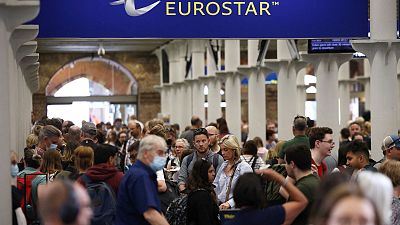Why are there long Eurostar queues at St Pancras?

Eurostar’s London to Paris route is the linchpin of many European adventures. Whether you’re off on a bigger rail trip or spontaneous weekend away, the undersea train holds a special place in travellers’ hearts – and workers’ itineraries.
With airports still struggling and many looking to travel sustainably, train stations are an increasingly attractive option. It takes just over 2 hours to get between London St Pancras and Paris Gare du Nord, and – in theory at least – you save a lot of time and stress checking yourself and your bags in.
Not to mention the CO2 savings: one flight is the equivalent of up to 13 Eurostar journeys in terms of carbon footprint. That’s a lot of croissants and afternoon teas you could enjoy before even scraping the sides of a plane’s emissions.
Delays at Paris Gare du Nord this week
Those travelling from Paris Gare du Nord faced lengthy queues yesterday morning (28 July), stretching from the lower concourse up the escalator to the terminal.A technical fault on one of the trains meant that four services were delayed in total, a Eurostar spokesperson told Euronews Travel.
“Chaos in passport control,” one passenger tweeted, “One of your very patient staff @Eurostar asked for a show of hands for the train due to leave in 15 min, mate it’s everyone you can see…”
“This was due to a broken train on the French high-speed line which meant it closed to all traffic and subsequently caused unexpected delays to our services,” Eurostar clarified. “Of course this kind of thing happens from time to time and we work hard to look after customers if and when it occurs.”
Is Brexit to blame for long queues at London St Pancras?
While technical faults can happen on any line, the long queues at London St Pancras point to a systemic issue. Many people say Brexit is to blame, as it has required more stringent checks – thereby slowing down the check-in process.
“Border checks for Eurostar between the UK and the continent take slightly longer due to the requirement to manually wet stamp UK passports,” a spokesperson explained, “and so we are asking customers to leave more time to check-in.”
The company foresaw Brexit would create problems. In a submission to the House of Lords in November 2016, Eurostar raised concerns about the government’s insistence on leaving the customs union. “New customs obligations would be very difficult to put in place in the restricted space available in stations,” it warned.
“Eurostar operates out of highly capacity-constrained stations in each of its principal locations,” the company added. “These are listed buildings in city centres and cannot be re-modelled without significant investments and years of planning. There is no capacity at these locations to remodel the use of space.”
Eurostar: How early should I check in before my train?
After January 2021, Eurostar put its recommended check-in time up to around an hour. But the latest guidance is that passengers on standard tickets should arrive 90 minutes before departure at St Pancras and 90-120 minutes before departure at Gare du Nord.
Arriving any sooner than this is not advised, as you could end up overcrowding the station and ahead of people whose train is departing before yours.
This all comes under the category of being a considerate traveller. You don’t want to be “the couple with 3.30pm tickets getting shirty with staff because they couldn’t queue jump ahead of people waiting for the 1.30pm train,” as one man on 24 July described.
Although queue photos are stressful to see for those with upcoming trips, passengers have noted that Eurostar staff are managing busy situations well, and calling people forward when necessary.
And, as the space between security and the platform is significantly shorter at St Pancras than Gare du Nord, it’s worth remembering you’re seeing the iceberg rather than the tip.
Will Eurostar increase its services between Paris and London?
Eurostar typically runs 13 trains from London to Paris a day, carrying up to 900 people. A fully-loaded Eurostar, for reference, weighs around the same as 77 double-decker London buses, or 140 African elephants.
So it’s a huge operation already, but could more services help ease demand and delays?
The operator is keen to add four more services, according to a report in the Telegraph newspaper on Sunday, but is being held back by French border police and security staff who say 17 would be too many to handle.
“We have had constructive discussions with the authorities on how we can work together to continue to increase our services,” Eurostar tells Euronews Travel.
In contrast, the number of commercial planes in service is set to increase by 47 per cent this year, Cirium analysts predicted in December 2021.
“In Gare du Nord, the French border police have committed to increasing resources, the douanes have added staff and opened more lanes, and in Autumn there will be an increase in the number of UK border gates which will help to further streamline the check-in process,” Eurostar adds.
Though an influx of travellers has overwhelmed transport providers across the continent this summer, it’s clear the desire for train travel is here to stay.
According to a recent survey of 1,000 business travellers by Eurostar, over half of people (56 per cent) said that choosing sustainable travel options is more important now than before the pandemic. While a quarter revealed that their employer is making train travel mandatory for work now, a figure that rose for smaller businesses.
